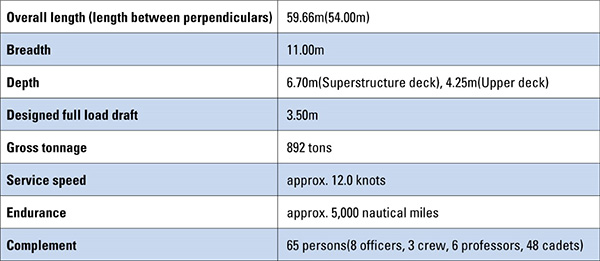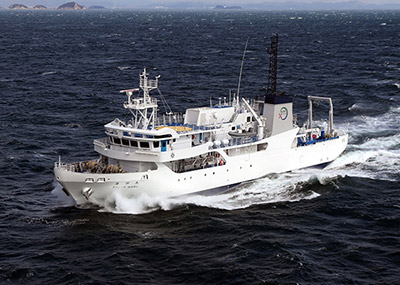Ocean Newsletter
No.532 October 5, 2022
-
Assessing the Current State of Acidification in Japan's Coastal Areas and Adaptation Measures
ONO Tsuneo (Chief Scientist, Fisheries Resources Institute, Japan Fisheries Research and Education Agency)
Ocean acidification is one of the problems of global warming. In order to investigate the state of ocean acidification in Japan’s coastal areas and its impacts on coastal organisms, the Ocean Acidification Adaptation Project was launched in 2020 on a grant from The Nippon Foundation. The two-year study has already begun to provide insight into the causes and effects of acidification, and it’s becoming clear that technology used for improving coastal water quality is useful for limiting acidification. We are anticipating effective measures for adapting to acidification in Japan’s coastal regions.
-
Kobe University’s New Training Ship the Kaijin Maru
KATSUI Tokihiro (Professor, Kobe Ocean-Bottom Exploration Center, Kobe University)
The handover ceremony for Kobe University's new training ship, the Kaijin Maru, was held on March 23, 2022. The ship has now embarked on its vital mission of fostering maritime human resources. The Kaijin Maru is a next-generation, high-performance training ship, equipped with various functions. This article describes its features and functions.
-
Towards the Conservation, Nurturing, and Sustainable Use of Precious Corals
KUMON Fujio (Visiting Professor, Center for Advanced Marine Core Research, Kochi University) ,MEZAKI Takuma (Director, Kuroshio Biological Research Foundation)
The recent economic boom has led to increased harvesting of precious corals, creating concern that stocks of this slow-growing species may become depleted. Along with regulating harvested amounts, efforts are being made to artificially propagate precious corals (aquaculture) by embedding live branch tips in a concrete disk substrate for their release and cultivation. Due to the ecological characteristics of these corals, their sustainable utilization requires a long-term commitment spanning decades.
Kobe University’s New Training Ship the Kaijin Maru
[KEYWORDS] Deep Sea Exploration / Atmosphere and Marine Environment Surveying / Support Functions for Disaster-stricken AreasKATSUI Tokihiro
Professor, Kobe Ocean-Bottom Exploration Center, Kobe University
The handover ceremony for Kobe University's new training ship, the Kaijin Maru, was held on March 23, 2022. The ship has now embarked on its vital mission of fostering maritime human resources. The Kaijin Maru is a next-generation, high-performance training ship, equipped with various functions. This article describes its features and functions.
Background to Construction
The Kaijin Maru is the successor to the Fukae Maru, which contributed to the development of maritime human resources for 35 years as a training ship for the Kobe University Graduate School of Maritime Sciences. The handover ceremony for Kaijin Maru was held on March 23, 2022. Its focus on developing professional human resources to support our maritime nation remains unchanged from the Fukae Maru. However, functional enhancement as a high-performance training ship was the major issue to resolve, ensuring it can meet societal demands. Kobe University's educational and research philosophy in maritime-related fields is to "Cultivate global maritime human resources who can actively contribute to a maritime-related field on a high-performance training ship.” Based on this philosophy, three fundamental directions were formulated for the ship’s construction: 1. Maintain and improve fundamental training ship functionality; 2. Add functionality needed to develop maritime human resources; and 3. Provide support and contribution to disaster-stricken areas at the time of disaster.
A High-Performance Training Ship
The main specifications of the Kaijin Maru can be seen in Table 1. The Fukae Maru had an overall length of 49.95 m and a gross tonnage of 449 tons, so the Kaijin Maru is approximately 10 m longer and 440 tons larger in gross tonnage. These increases were not made purely to increase its size. Instead, its size resulted from studies on how to meet current laws and regulations and keep operating costs as low as possible while providing more necessary equipment. Nevertheless, to maximize the benefits of the larger hull, space was secured for a bridge that could accommodate a large number of people, a training area, and a lecture room. Furthermore, the arrangement of the tables in the lecture room can be changed to accommodate multiple uses. In addition, onboard living conditions were improved, including those related to sanitation, in consideration of the ship’s joint use by men and women. Finally, since the COVID-19 pandemic began during the detailed design process, the ship’s specifications were hastily changed to allow forced ventilation. Functional improvements to ship operations include mechanizing deck equipment related to mooring to reduce crew workload and introducing a dynamic positioning system (DPS) and a track control system that keeps the ship on a constant course. DPS also provides significant benefits for ocean observations and seafloor exploration. Electronic chart information, information on ship operations, and weather and sea condition information are managed centrally through the ship's LAN and can be displayed in an integrated manner at various locations on board. This arrangement facilitates access to information required for optimal ship operations. In addition, to utilize actual ship data for educational and research activities, navigation data is recorded by equipment for collecting voyage data, which can be used to create scenarios for ship maneuvering simulators. This data will also help enhance land-based educational activities.
The machinery part is characterized by its propulsion control space placed on the bridge, which has the same function as an engine control room. This configuration aims to improve the ability of maritime engineers and navigators to communicate closely and for them to understand each other's actions. This system was inherited from the Fukae Maru and can be called the “Kobe University System.” While the International Convention on Standards of Training and Certification and Watchkeeping for Seafarers (STCW Convention) requires high standards of seafarer teamwork and leadership among crew members, Kobe University is proud that its method is an effective one and satisfies those standards. It also enables remote operation and remote equipment monitoring and provides enhancements for educational and practical training related to operating and controlling engines.
The Kaijin Maru also features a full lineup of survey and research equipment1. There is now space for onboard laboratories (dry and wet laboratories), which were not available in the Fukae Maru, and measurement data from various observation devices can be easily gathered via the onboard LAN. Due to its range of activities, the ship is characterized by its specialized ability to survey the ocean and seafloors at depths shallower than 2,000 meters. It currently has world-class exploration and observation capabilities in these areas. One example of the ship’s exploration systems is its seismic reflection survey functionality. Its stratum exploration system has a new sub-bottom profiler that emits acoustic pulses directly downwards to analyze the cross-sections of geological layers. This system enables the exploration of subsurface structures several hundred meters below the seafloor at a resolution of less than 10 meters. In addition, the air gun compressor required for producing oscillating acoustic pulses is permanently installed in the engine room, allowing for agile surveying. The Fukae Maru has already conducted various surveys of the Kikai Caldera2 and other areas. However, even more diverse oceanographic observations and explorations are expected to be conducted with the Kaijin Maru's wide array of research and observation equipment.
 ■ Table 1 Main dimensions, etc. of the Kaijin Maru
■ Table 1 Main dimensions, etc. of the Kaijin Maru
Support Functions for Disaster-Stricken Areas
The Kaijin Maru has the important function of supporting and contributing to disaster-stricken areas by supplying water and electricity and transporting other supplies, and this is one of the reasons it was classified as a highly-functional training ship. The Fukae Maru was equipped with an onboard freshwater tank to supply water for drinking and other uses. However, the Kaijin Maru is equipped with a new reverse osmosis type fresh water generator (that can produce 10 tons a day) to enhance its water supply capabilities greatly. Its desalinized water has a salt content of less than 500 ppm, which meets the standard for drinking water. The ship’s capacity to supply power to shore has also been improved by increasing the size of its onboard generators. The Kaijin Maru also has space for two 20-foot containers on the deck for transporting relief supplies. Under normal circumstances, this space can accommodate a container laboratory, enabling it to be used for various observation activities. In addition, a winching area has been installed on the compass deck, which can help with the transport of supplies by helicopter. This feature will contribute to the transportation of relief supplies even when, for example, port facilities in the disaster area are damaged, and it is difficult to land on the shore. Furthermore, since transporting goods using large drones is expected to become possible in the future, the usage of the winching area for transporting goods is also expected to expand.
Finally, a word about the exterior of the Kaijin Maru (Figure 1): Mr. Ken Okuyama (Kiyoyuki Okuyama), a world-renowned industrial designer, was commissioned to design the ship’s concept. I sincerely hope this training ship’s extraordinarily innovative design will attract many young people and make them want to learn about the ocean at Kobe University, where the Kaijin Maru is located. Japan is a maritime nation, and I believe that the importance of developing maritime human resources will continue to grow. I would like to conclude this article by stating that Kobe University and the training ship Kaijin Maru are strongly committed to playing a part in these efforts. (End)
 ■ Figure 1: Exterior of the Kaijin Maru
■ Figure 1: Exterior of the Kaijin Maru
- 1.See page 17 of the pamphlet for information on the Kaijin Maru’s suite of survey and research equipment (http://www.maritime.kobe-u.ac.jp/)
- 2.Yoshiyuki Tatsumi: "Probing the Kikai Submarine Giant Caldera - the challenge to predicting a supereruption -," Issue No. 451 of this journal (published May 20, 2019)
https://www.spf.org/opri/newsletter/451_2.html
